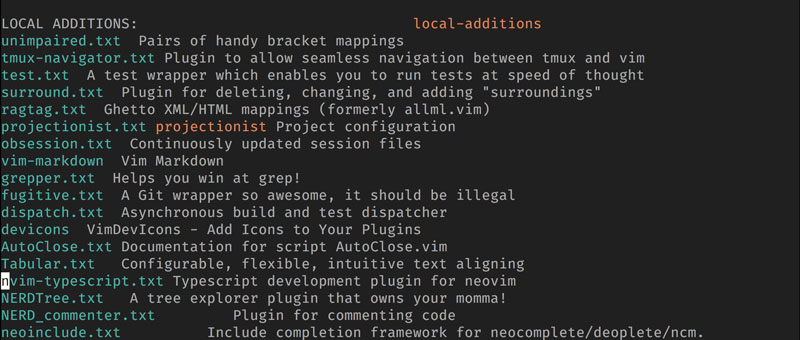

Vim plugins code#
Vim only loads the autoload code if one of the commands defined in the plugin portion gets called. Keeping this code in the autoload directory allows Vim to be more efficient about using it.
Vim plugins install#
However, if you already have cURL installed, you can install vim-plug with the following command: sudo curl -fLo ~/.vim/autoload/plug.vim -create-dirs
Vim plugins how to#
You can get details on how to install vim-plug in our guide Introduction to Vim Customization.
Vim plugins free#
Several other plugin managers exist though, so feel free to choose an option that works best for you. To help keep plugins organized and more maintainable, this guide uses the vim-plug plugin manager. The instructions that follow show how to set up the prerequisites and implement the code for the plugin. The example plugin displays the time, looks up word definitions, and gives spelling suggestions. This section walks you through creating a Vim plugin. Even if you only ever keep the plugin for yourself, having more complex Vim code in a plugin format can help you keep your Vim configurations more organized and maintainable. Following some plugin standards and hosting your plugin on GitHub makes your plugin accessible to others through plugin managers like vim-plug. Plugins are the preferred way to distribute your Vim code for others to use.

Commands that require elevated privileges are prefixed with sudo. As you can see, the plugin installed without us having to enter anything, and then the window was closed as soon as it was done.The steps in this guide are written for non-root users. If there is a missing plugin, it'll run the command, plug install, and then install whatever is missing. This autocommand will run whenever Vim starts. We can take this a step further with a few additional lines of Vim script. We'll enter command mode, and use the command exit to close the installation window.
Vim plugins update#
As soon as the plugin installation is done, Vim will update and we'll have the plugin running. We'll get a small window on the left saying that we're installing the plugin.

Now we can save and quit Vim, start the editor back up again, and execute plug install. In this case, we're loading a repo from tpope and his plugin, Vim sensible. We'll use the command plug and give it the GitHub user name, and then the repo we want to load. So, will add a simple plugin, Vim sensible, which just sends a bunch of normal defaults for us. Then we'll add plug and tell Vim-plug that we're done trying to load any plugins. We'll add call plug begin, and then say a directory where we want our plugins to be installed. With that installed, let's open r.mrc and add a few lines to the file. To get started, we'll first need to copy the Vim-plug script into our. Vim-plug does have a few requirements, so be sure to read over the documentation for your platform. Vim-plug gives us a simple way to declare what plugins we want to load, to allow in session through Git, and then reload the editor with the plugins added.

In our case, we'll use the Vim-plug plugin manager. To add plugins, you can either manually add them to your file system, or you can use a plugin manager to automate it. Vim's scripting ability allows you to use external files to enhance the Vim's functionality.


 0 kommentar(er)
0 kommentar(er)
